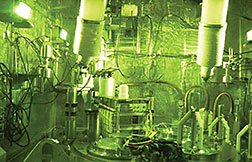- Number 392 |
- July 8, 2013
Wireless project can improve DOE, NNSA secure communications

SRS hot cell.
While wireless technology has become commonplace for many applications, concerns about security have traditionally prevented its use for transmitting data that is not intended for public disclosure. A project at the DOE’s Savannah River National Laboratory (SRNL), however, is combining the benefits of wireless networks with security levels suitable for even classified data.
SRNL has collaborated with the National Security Agency (NSA) on a design for classified data transmission, without the use of the traditional Type 1 encryption products. The new secure wireless network design could be used for sensors across the DOE complex, in addition to uses by other federal agencies and industrial control systems at critical manufacturing facilities across the nation.
The development has reached a major milestone with NSA’s approval of prototype hardware for use in certain classified communication operations. The approval of this prototype hardware marks the culmination of the first phase of a project that began four years ago with preliminary scoping to understand the needs and existing technologies.
The recently approved hardware includes the component parts of a prototype stand-alone wireless radiation air monitoring system designed by SRNL for use in nuclear facilities. The system combines robust radiation sensing technologies with an ultra-secure short range wireless network from General Dynamics, the company SRNL contracted to develop components for the wireless system. While the radiation sensor is specific to nuclear facilities, the short range wireless sensor network is adaptable to other applications that require high reliability with ultra-secure protection of the wireless data network.
DOE, which has multiple missions related to work with nuclear materials, could benefit greatly from the ability to use this type of wireless technology for radiation monitoring in nuclear facilities. Radiation monitoring in nuclear facilities is essential for operating the equipment safely and protecting personnel. With the cost of running cable into a radioactive process room as high as $2000 per foot, a wireless system could save millions per deployment. Another key advantage is the freedom of movement that comes when equipment is not restricted by wires and cables. The sensors can be placed directly in the area of concern, instead of pumping air to the sensors’ location.
Wireless air monitoring may prove to be more reliable than the wired equivalent, by reducing the number of components in the air monitoring system.
The wireless network design is based on Suite B cryptographic algorithms and meets the requirements outlined in a 60-page NSA specification.
Typically, classified government communications are protected by special “Type 1” encryption products controlled by the NSA. These encryption products have strict security controls that make them cumbersome to operate, and they take multiple years to design and develop. Since these products are only sold to the U.S. government, the market for the communications devices that use them is limited, making them significantly more expensive than commercial alternatives that solve similar problems.
The new approach uses “Suite B Cryptography,” which NSA has embraced as part of a strategy to improve information sharing within the U.S. and with coalition partners. It can be used to protect classified U.S. government information up to the Secret level. Since the vast majority of classified information is SECRET or below, approved Suite B products could significantly improve the speed and flexibility of deploying secure, commercial-off-the-shelf-based communications systems.
The issuing of an NSA approval letter represents the end of the first phase of the project and is a major step on the road to adopting wireless technologies in the DOE complex and classified wireless applications across the federal government. The second phase of the project will develop an improved production-ready wireless sensor interface module and is expected to start in FY2013.[Will Callicott 803.725.3786,
will.callicott@srnl.doe.gov]
